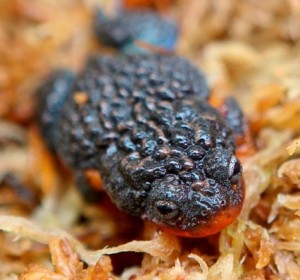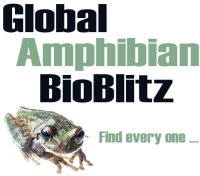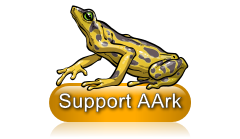 Species name: Spicospina flammocaerulea
Species name: Spicospina flammocaerulea
Common name: Sunset Frog
Red List status: Vulnerable (http://www.iucnredlist.org/apps/redlist/details/41052/0)
Distribution: South coast of Western Australia: east and north-east of Walpole.
Habitat: Permanently moist peat swamps.
Threats to survival: A very restricted geographic range means that this species is particularly susceptible to local catastrophes; inappropriate fire regimes; habitat loss through altered ground water tables (resulting from the loss of vegetation due to fire or disease); possibly feral pigs.
Reproductive behaviour: Males call between October and December from shallow pools, water seepages, large water-filled depressions, or open water along creek margins. Egg clutches contain fewer than 200 eggs each, and the eggs are deposited individually, often on algal mats just below the surface of the water. The tadpoles are free swimming.
 Interesting natural history notes: The climate in the region sunset frogs occupy is thought to have changed from subtropical wet to seasonally arid approximately five to six million years ago; the peat swamps it inhabits are therefore considered to be relicts of an earlier environment.
Interesting natural history notes: The climate in the region sunset frogs occupy is thought to have changed from subtropical wet to seasonally arid approximately five to six million years ago; the peat swamps it inhabits are therefore considered to be relicts of an earlier environment.
In situ projects currently underway: Population sizes are estimated annually through censuses of calling males at key populations throughout the species range, and data is being collected to improve knowledge of calling behaviour and how specific environmental, habitat and climatic parameters influence reproduction, survival and abundance.
Ex situ programs: The Native Species Breeding Program at Perth Zoo is currently conducting research into the husbandry and breeding of this species in captivity, so that relevant knowledge and skills are available should it become necessary to establish a captive breeding program in future.
How can we help this species? People can help sunset frogs by observing fire bans in the Walpole area. People living in the region could raise awareness of sunset frogs, their habitat requirements, and potential threats to their survival locally.
Other links: Sunset Frog – Department of Sustainability, Environment, Water, population and Communities.













